
28 minute read
Nautical tokens of love
Caribbean Sea. Merchant sailors, whalers and yachtsmen stopped to trade, sightsee and shop. One particularly popular store was Belgraves New Curiosity Shop in Bridgetown.
Surviving newspaper advertisements for the business from the later 1800s feature “Marine Specimens and Native Manufactures in Fancy Work” as a tempting gift idea for last-minute shoppers who didn’t want (or dare) to return home empty-handed. In fact, the Belgrave brothers’ emporium met many of the same needs as today’s airport store. Just such a newspaper clipping was discovered in the 1960s by a restorer working on a sailor’s valentine. Further research made it clear that most of these shell creations were commercially made and purchased at Belgraves and similar shops.
Many Barbados women were of English descent and familiar with designs for fancy needlework that could be adapted to working with tiny shells. They developed a thriving cottage industry making and selling these distinctive souvenirs.
The island origin of the valentines is further proven by the fact that while there are hundreds of thousands of different species of shells, only about three dozen were used in sailors’ valentines. And those species are all native to the West Indies. Occasionally shells from other places, mainly Indonesia, are found in antique sailors valentines, but they are fairly rare exceptions. Those Indonesian shells were imported to America and Europe by a London-based entrepreneur whose family business eventually moved from shipping shells to transporting petroleum. The company name today is Shell Oil, the U.S.- based wholly owned subsidiary of Royal Dutch Shell.
The majority of valentine greetings today are purchased by women. The surviving sailors valentines are enduring and endearing reminders of the era when “A Token of Esteem” painstakingly worked in tiny seashells was a heartfelt gift from a returning seafarer.
For more, contact Katie at kwhittle@ skinnerinc.com or 212-787-1114. The origins of Valentine’s Day as an occasion for exchanging tokens of affection dates from at least the Middle Ages. The English poet Geoffrey Chaucer mentioned Feb. 14 as a day for romance because it was widely believed to be the date when birds began to choose their mates. That sentimental tradition has continued to flourish.
At first, Valentine’s Day was marked with handwritten notes and poems and the exchange of small keepsakes. The Victorian age gave fuller rein to the expression of romantic feelings. Colorful printed cards and more elaborate gifts became widespread. Among the most appealing examples of this new emotional openness are the shell mosaics known today as sailors’ valentines.
Originally made mainly between the 1830s and 1900, these sentimental souvenirs are treasured survivors today. They are readily recognized by the materials, seashells less than ½ inch in size, and the size and shape of the finished items, generally 8 to 12 inches across in octagonal, glass-covered wooden frames a couple of inches deep.
Most valentines were made in pairs, hinged together on one side. When the clasp was released, the case opened to reveal symmetrical patterns composed of dozens of small shells glued on a backing of NAUTICAL TOKENS OF LOVE BY KATIE BANSER-WHITTLE cotton batting. Often the design included a central motif such as a heart, anchor or compass rose, or a sentimental motto like “Forget Me Not” or “A Token of Affection.” Research has shown that these ingenious examples of folk art were rarely if ever made by the sailors themselves. Nor were they presented to sweethearts, wives or favorite female relatives on Valentine’s Day, unless the giver happened to arrive home in midFebruary. The true story behind sailors’ valentines is even more intriguing. The 19th century was an age of discovery. Science blossomed, natural history was all the rage and travel became easier. These trends combined to make collecting of all kinds popular and one favorite category was shell collecting. It even had a name — conchylomania. Some of these sandy souvenirs were used for hobby and decorative purposes, including combining them into mosaic-like geometric patterns.
At the same time, large numbers of men were engaged in maritime occupations — whaling, fishing, trading and exploring. After a long period away from home, many seafarers wanted to return with colorful souvenirs for the women who had waited anxiously ashore.
As far back as the 1600s, the West Indies island of Barbados was one of the most important ports of call in the busy HOME & DESIGN WHAT’S NEW AGAIN Sailor's Seashell Valentine, (late-19th century), Barbados. Estimate — $1,000-$1,500. Sold at Skinner Inc. for $8,813.
The Perfect Venue for Any Occasion
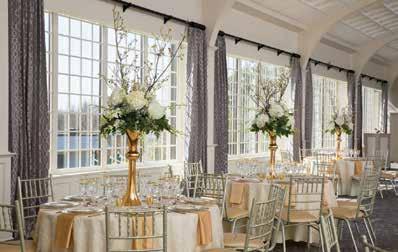

Weddings
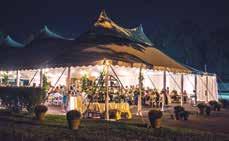
Mitzvahs
Corporate Events


Special Occasions
Nestled on 28 acres of beautifully manicured gardens, the newly redesigned Serafina
offers distinguished charm, Italian-inspired cuisine and an elegant setting
For a truly memorable experience, call 203.322.6950 GH
1620 Newfield Avenue, Stamford, CT 06905
serafinaic.com
serafina@italiancenter.org
BEYOND ‘CASABLANCA’
BY JEREMY WAYNE
TRAVEL WANDERS From the moment Rick Blaine put Ilsa Lund on the plane to Lisbon in “Casablanca,” Morocco’s main city and commercial hub seemed to go into terminal decline. Indeed, the only reason any serious traveler might have been to Casablanca recently was to the airport — en route to Marrakech or Fez. But after decades in seedy oblivion, Casa, as locals call it (and please get with the lingo), is suddenly hotting up. The 2 mile-long Corniche, or oceanfront drive, has been given a face-lift; the jaw-dropping Art Deco district, with more than 20 architecturally important movie theaters, is being painstakingly restored; and a new cultural center — The Grand Theatre of Casablanca, the largest in Africa with a concert hall, theater and vast retail space — is slated, after a long delay, to fully open this year.
Last year, meanwhile, saw the inauguration of Morocco’s new TGV, or high-speed train service, which now whisks you from Casablanca up to Tangier, a distance of some 200 miles, in a little over two hours. And in the heart of the Casablanca action is the very swish new Four Seasons hotel, right on the ocean, with its 186 ergonomically perfect, cool white-and-taupe guest rooms, 30 suites the size of football pitches, a handsome pool with snap-to-it poolside service, a private beach with its own miniature sand dunes and a very beautiful spa for rhassoul clay wraps and Paris-brand Biologique Recherche skin treatments, exclusive to the hotel. In Mint, one of the hotel’s four restaurants, they do breakfast pastries the equal of anything in Paris, and in its fabulous fish restaurant, Bleu, you eat amazing Dakhla oysters and sashimi of just-caught Atlantic sea bream with a view of the breakers rolling in and the Point d’El Hank lighthouse. If Casablanca isn’t on your bucket list — and you could be completely forgiven if it wasn’t, because frankly who even knew? — it should be. Then again, Tangier is a contender. With a magnificent location at the very northwestern tip of Africa, where the Mediterranean meets the

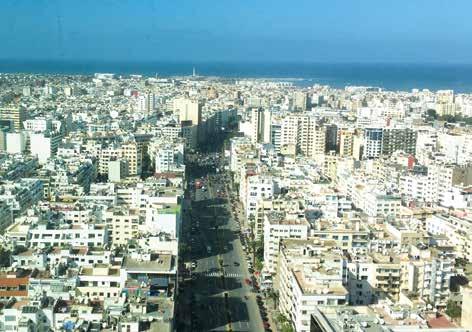
Clockwise from above, sunset over Palais Amani, Fez. Courtesy Palais Amani; and dye packets in Tangier Medina and Casablanca view. Courtesy Jeremy Wayne.

Atlantic, Tangier was an international city between 1923 and 1952, administered by France, Spain and Great Britain, as louche as it was rundown and exotic, made infamous by its cast of ex-pat residents and returning writers and poets, Allen Ginsberg, Jack Kerouac, Paul Bowles and the notoriously indiscreet English playwright Joe Orton, among them. Kif and sex were cheap, and self-respecting people stayed away, much to the delight of the Beats and other nonconformists.
And so Tangier was reviled by the former king of Morocco, Hassan ll, but his son, the rather more progressive king Mohammed VI, has taken a different view. Since 2010, he has personally promoted huge investment in Tangier, which has resulted in a new commercial port, clean beaches, a new airport terminal and increased tourism generally. Indeed, the town, with its ravishing medina (old quarter) and Casbah (where former resident, Barbara Hutton, famously had all the

medieval arches widened when she came to live here in the 1950s, so that her Rolls-Royce could more easily pass through) is looking positively spruce, and a clutch of new hotels and riyads (typical Moroccan townhouses) now cater to the most demanding tourists.
The classiest hotel, located on Tangier’s classiest street, Rue de la Liberté, has long been El Minzah, founded 90 years ago by a British aristocrat, Lord Bute. And following a recent revamp, it still is. At El Minzah, fezwearing factotums greet you on arrival and the atmosphere is reassuringly upscale. The quality of the food in the hotel’s restaurant, El Korsan, is also well above hotel average in this neck of the woods, the whole experience heightened by tarbouched musicians playing heady gnoua music, while valiantly smiling at the same time. They’re joined nightly by belly dancers who lift that undulating ritual from what is often seen as purely titillating entertainment to an almost sublime art form.
The Petit Socco (or “small souk”) at the center of Tangier’s medina, which not so very long ago crawled with hustlers, thieves and teenage prostitutes, is now so lickety-spit you could take your grandmother for dinner, without any fear of impropriety. In the corner of the square of the same name, the Palais Zahia, which was Tangier’s first bank, is now a 16-room hotel, the painstakingly restored building dating from 1903, complete with columns, frette-work, inlaid wood, marble and plasterwork. And yet another brilliant hotel choice in the city, is Nord-Pinus, a former pasha’s townhouse high up in the Casbah,
which owner Ann Igou has filled with furniture, collectibles and bibelots from around the world. It is staggeringly lovely.
Some 250 miles and an easy four-hour drive from Tangier across the ravishing Morocco hinterland, Fez is the oldest fully intact medieval city in the world. But while Fez has it all in terms of magnificent city walls, ancient palaces and a labyrinthine medina bursting with color (and incredible shopping), what it has long lacked is a really tremendous luxury hotel. Well, now it has several, among them Palais Faraj, a former Arab-Moorish palace outside the medina, which boasts a swimming pool in its courtyard and a top-floor restaurant and lounge, where the Moroccan food is exceptional and the view is second to none. Replete with bar and library, exquisite furniture and wonderful art, this clubby, sophisticated palace hotel is the last word in sumptuous urban chic. In a perfect world I would check in for six months and write a book. In the imperfect world we inhabit, two or three nights will have to suffice.
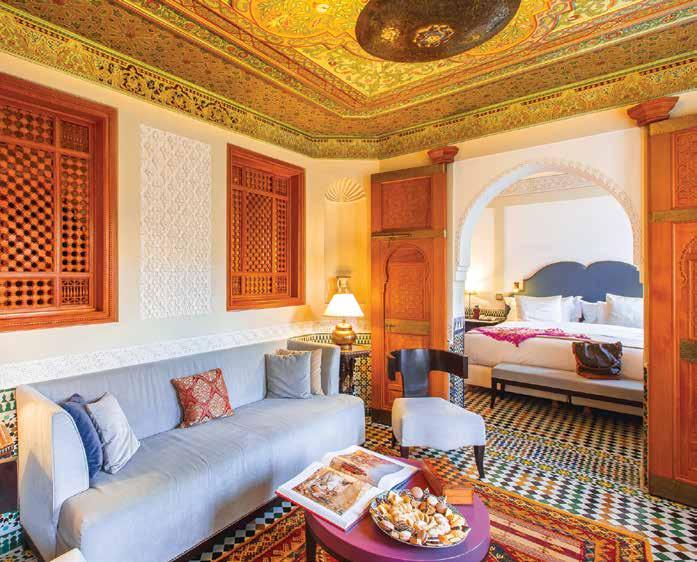
But save time, too, for Palais Amani. A 17thcentury palace situated by the main entrance to the medina, Amani — which is officially the largest riyad in the Fez medina — took four years to restore. It boasts carved plaster arches, zellij tilework, crimson rugs and fabulously rich upholstery, along with a vast central courtyard filled with orange trees (and the sounds of birds singing in them). Rooms here are the last word in comfort, from the handsome doubles to the luxurious suites, and service is so sweet and genuine it could make the most hard-bitten hotel guest weep. With joy, you understand. And forget Rick’s American Café in Casablanca. If you can tell me they mix a better Negroni anywhere between the Rif and the Atlas Mountains than in Palais Amani’s cozy bar, with its deep sofas and wonderful working fireplace, then I will eat my yellow babouches (Moroccan slippers).
For more, visit fourseasons.com, leroyal. com, nordpinustanger.com, palais-zahia.com, palaisfaraj.com and palaisamani.com.
Guest Room at Palais Faraj, Fez. Courtesy Palais Faraj.
Bring your camera and learn how to capture some amazing moments. as only an insider can See Africa

10-DAY KENYA SAFARI, NOVEMBER 2020
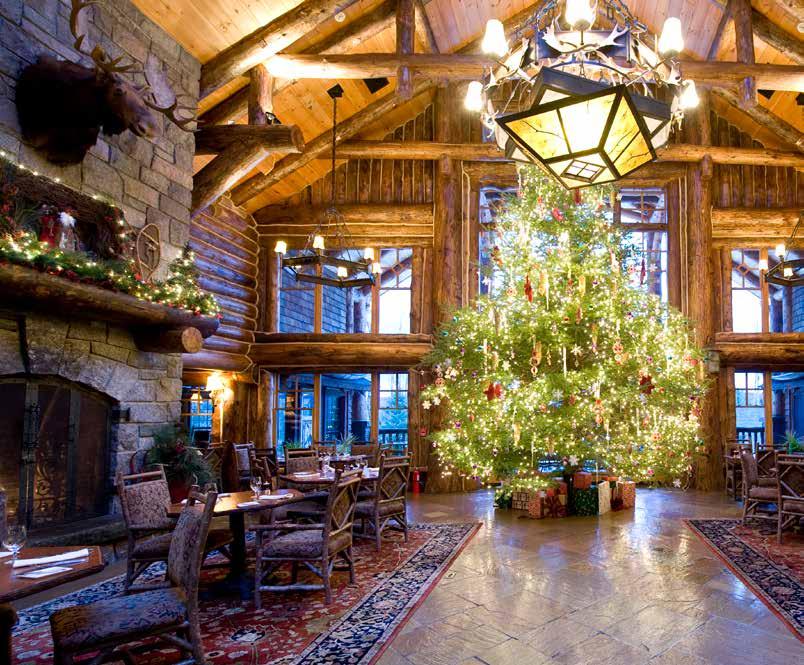
ROMANCING THE WINTER
BY BARBARA BARTON SLOANE
— Washington Irving
The charming village of Lake Placid is near the lake of the same name in New York state’s Adirondack Mountains. It’s known as a Winter Olympics venue (both the 1932 and 1980 Games were held here) and a hub for snow sports and other outdoor activities. There are 86 trails over 22 miles, three mountain peaks and, in the center of town, the snowy, sparkling Mirror Lake with a footpath around the entire shoreline. I took this pretty amble and wanted to shout: “Let it snow, let it snow.” Happily, it did.
The impressive Adirondacks have the highest vertical drop on the East Coast, providing skiing and snowboarding for all skill classes and interests. At the Olympic Sports Complex, you can ski jump, bobsled ride or experience the Ausable Chasm and High Falls Gorge. You can mingle with the Wolves at the Adirondack Wildlife Refuge — a 50-acre realm of interpretive trails, rescued animals such as hawks,
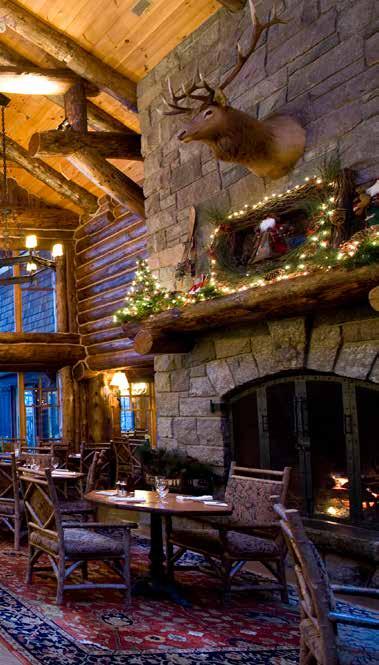

owls, foxes, and bobcats — or be daring and run with the pack on a dogsled ride on the lake. Or how about a horse-drawn sleigh ride as you nestle under thick blankets to make this winter wonderland a reality? I chose careening around the lake on a sled pulled by a brace of spirited huskies — a memorable experience, to be sure.
A GILDED AGE GETAWAY Tucked into these picturesque woodlands of the Adirondacks’ high peaks is the awe-inspiring Whiteface Lodge. Considered one of the best hotels of its kind in the country, the lodge sits in a 6-millionacre recreation area known as Adirondack Park, whose visitors have included poet Ralph Waldo Emerson, socialite Marjorie Merriweather Post and assorted Vanderbilts. The lodge, a Forbes four-star, AAA Four-Diamond hotel, evokes the splendor of the late-19th century’s Gilded Age and the Great Camps. It includes three restaurants, a spa and 92 all-suite guest rooms, featuring hand-crafted furnishings and private cedar and mahogany balconies and terraces to take in the fresh mountain air. Some appealing elements in each room, especially welcome right now — heated slate floors, warm wood paneling and cast iron gas fireplaces. Once settled in, it was hard for me to tear myself away from this snug environment but the enchanting lodge beckoned. I had to explore.
Especially as it was time for dinner at Kanu, the lodge’s fine dining establishment. I entered a towering three-story Great Room and was dazzled by its Great Camp splendor — elk, deer and moose heads mounted high on the walls, majestic chandeliers embellished with antlers, two blazing granite and stone fireplaces and, above it all, great hand-hewn log beams rendering this truly great room somehow cozy. I enjoyed a view into the bustling kitchen and a fine Adirondack-inspired repast.
Named one of the top 100 spas in North America by Condé Nast Traveler, the Spa at Whiteface Lodge suggests the natural beauty and bounty of the Adirondacks with signature treatments that range from a Lodge Mud Wrap and an Apple Cider Masque and Massage to an Outdoorsman Facial. (Wimps need not apply.) I relaxed in the steam room and was quickly brought back to life with a challenging dip in the heated indoor/outdoor pool.
STARS FELL ON ADIRONDACKS One of the most enchanting features of Whiteface Lodge is its luxury lean-tos, unique to the Adirondacks and the epitome of rustic elegance. Inviting spots fitted out with sink-in-soft sofas and chairs, warm blankets, bright throw rugs and fire pits, the lean-tos are sheltered on three sides and open to star-gazing. In my case, open also to a lovely full moon, beaming down in all its magical glory. This special place, my friends, is dream-worthy and, if so inclined, downright romantic. Not to be missed.
The property can accommodate year-round conferences, business retreats and social gatherings of up to 200 guests, with a dedicated staff expert in ensuring a seamless experience. Bowling, ice skating, golf — it’s all here at this truly four-season destination. In the village there are fun boutiques and, nearby, the Olympic Museum exhibits captivating memorabilia and artifacts.
Whiteface Lodge — a cozy wooded retreat in winter, a cool, forested haven in summer — an exceptional place to visit anytime. As for me, I’m already planning my warm-weather return to one of those star-studded lean-tos — this time no need for blankets. I’ll have the romance of the place to keep me warm.
For more, visit lakeplacid.com and thewhitefacelodge.com.
TRAVELING ROYALLY
BY DEBBI K. KICKHAM
TRAVEL WANDERS What globetrotter wouldn’t want a GlobeTrotter suitcase?
Synonymous with great British design, Globe-Trotter is a luxury travel lifestyle brand producing gorgeous handcrafted luggage and leather collections. Established in 1897, GlobeTrotter handcrafts suitcases and travel accessories in Hertfordshire, England, with highly skilled artisans using original
manufacturing methods and machinery that date from the Victorian era.
Globe-Trotter products have been used by an enviable client list over the years from Capt. Robert Falcon Scott and Sir Winston Churchill to actors Daniel Craig and Eddie Redmayne and model Kate Moss. Collections are available to purchase online at Globe-trotter.com and in the Globe-Trotter flagship store, along with a bespoke service, at 35 Albemarle St., London. You can custom order your luggage in practically any color of the rainbow. And you can only imagine the bespoke luggage tags. A Globe-Trotter vanity case costs anywhere from $1,000 to $1,600. Bespoke bags are about three times the cost of an “off the rack” item you can purchase in the store.
Oh yes, and the company produces luggage for Queen Elizabeth. On her honeymoon, the Queen used her GlobeTrotter suitcase — a favorite among the royal couple’s many wedding gifts —which she still uses today.
Every Globe-Trotter suitcase is produced from a sheet of vulcanized fiberboard — a unique material invented in Britain during the 1850s that is as strong as leather, yet light as aluminum.
A blunt-edge Victorian guillotine — you heard that right — cuts the fiberboard, using only the weight of the blade. Each panel is expertly molded into shape using a method patented by Globe-Trotter in 1901. Components and handles are attached by hand.
Inspired by the 1970s jet set’s ski vacations to the snowy Alps, Globe-Trotter Globe-Trotter’s Safari Collection in ivory. Courtesy Globe-Trotter.
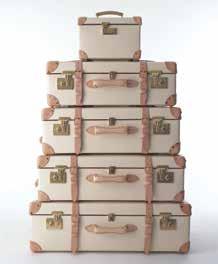
recently created the St. Moritz collection. It focuses on red, navy and ivory — colors selected in retro homage to the bright skiwear of the ’70s. Globe-Trotter’s iconic navy case is now embellished with a contrasting red handle and stitching details, while a new ivory case features striped external webbing straps in the trio of hues. The ivory case comes complete with a fun lining depicting skiers descending on the inside of the lid. GlobeTrotter has also introduced an amethyst color to its Deluxe collection. Matching the existing Deluxe offerings, each case boasts a high-gloss, metallic exterior and a plush interior lining. Inspired by the colors and hues of the gemstone, the collection ranges from a handbag-sized miniature case to a 33-inch suitcase, and will impart a regal air to anyone traveling with it.
KLM AT 100 In October, KLM Royal Dutch Airlines celebrated its 100th anniversary. Founded in 1919, KLM is the first commercial airline that is still flying under its original name. Ever since KLM’s first commercial flight, the company has set its sights on progress.
One of its most innovative approaches, begun in 2009, is sustainable aviation fuel, which reduces the CO2 emissions from each flight by up to 85%. In 2011, it flew the first commercial flight on biofuel and, a year later, launched the Sustainable Aviation Fuel Program for corporations. Today KLM uses 57 times more sustainable fuel than in 2011.
In keeping with tradition, KLM marked its anniversary with the presentation of a new Delftware miniature house, a moment eagerly awaited by faithful collectors all over the world. This year’s miniature is a replica of Huis ten Bosch palace in The Hague, the home of King WillemAlexander and his family.
The KLM Crown Lounge experience is also taking on new heights with the opening of Blue, the Crown Lounge’s new restaurant and bar. You can relax and unwind in this new space before departure or upon arrival at the Amsterdam Airport. Michelin-starred chef Joris Bijdendijk’s belief in the power of working with local and authentic ingredients infuses Blue’s menu. Only the best Dutch ingredients are used to create an authentic culinary journey at your table.
In addition to the restaurant, you can also relax in the Blue bar, an elegant fusion of a coffee lounge and cocktail bar. Whether you want to kick-start your morning with a special blend of coffee beans or wind down with a cocktail made from one of the 300 local and international spirits, the Blue bar will deliver. Can you say Dutch treat?
BACK AT HOME I speak from experience when I say that traveling, by necessity, requires travelsized samples. I typically keep many of my cosmetics in a beauty case — which functions as an extra drawer — but I now have an even better solution. It’s an adorable, sassy and classy rose-gold mini refrigerator that was developed specifically to house beauty lotions and potions. The Fria Refrigerator is an adorable addition to your bathroom or walk-in closet, where it will house your traveling dream creams, facial rollers and masks. For example, serums with vitamin C typically need to be chilled. Here is a cool cooler that I’m juiced up about. The Fria Skincare Fridge is now available at vanityplanet.com and retails for $89.99. For more about Debbi, visit Debbikickham.com.

ROSY OUTLOOK
BY JEREMY WAYNE
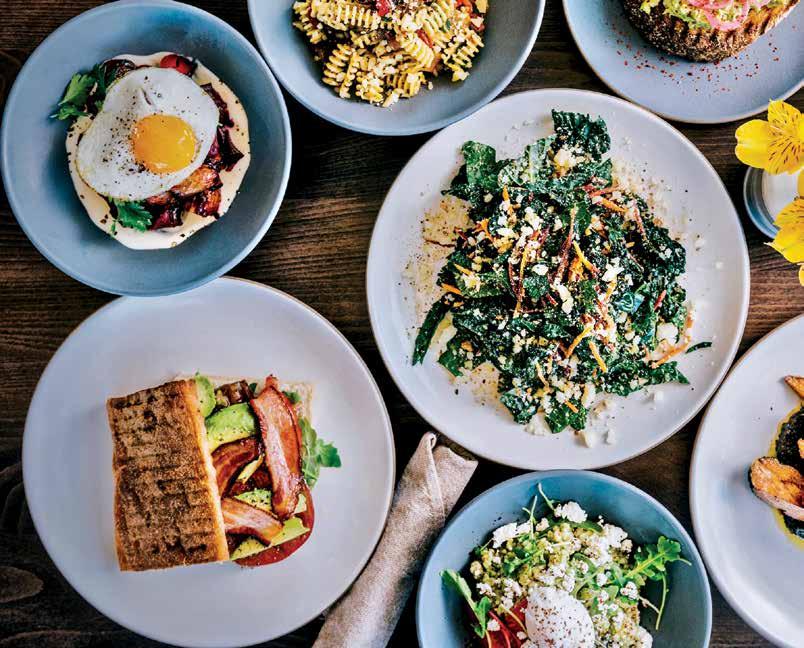
It’s official: California has come to Westchester in the form of Maple & Rose, a clean, contemporary café just opened on the first floor of the tony Grand Street Lofts building on Mamaroneck Avenue. Between the school and the station, this cheerful café brims with light, with bonhomie and exudes an easy laidback charm. As for all those glass windows, it’s a veritable solarium on even the grayest winter day.
Clean lines, hardwood floors and undressed teak tables and chairs are the look, a pot of orchids on a square central table adding some welcome color. Outside, a wide terrace sticks two figurative fingers at the traffic on Mamaroneck Avenue and is going to be a terrific place to dine come the warmer weather (or any time, under heat lamps).
Open for breakfast and lunch daily and dinner every day except Monday and Tuesday, Maple & Rose’s short but well-thought-out menus tick all the boxes. At breakfast, avocado and Romanesco cauliflower are right on trend, while soft scrambled eggs sitting on wonderful sourdough toast with, say, smoked salmon and labneh, or — even more temptingly — truffle butter and The menu changes regularly to highlight the best that each season has to offer.

pecorino, set you up for the day. If on the other hand, a shot of espresso on the hop is your thing, then head for the bar, where you can also pick up some top-flight breakfast patisserie, a flaky butter croissant or pain au chocolat, perhaps.
At lunch and dinner, simple salads join the lineup, along with a carefully made orzo risotto, rendered rich with pecorino and winter truffles. My dinner companion raved about his roast chicken on a recent evening, buttery soft and served with Delicata squash and a punchy salsa verde. The short ribs — at $26, something of a bargain in my book — also draws plaudits.
Launched last April by Matt Gorney, who lives in Eastchester, and his business partner Ryan Hart — the two met while they were both working at Chipotle — this is a first restaurant venture for both of them. The café is already popular with groups (a meeting of ex-pat British moms is in full swing the morning I look in for breakfast), while the quality of the produce and fairness of the pricing means Mason & Rose has started to attract customers from a wider radius.
Service is informed and very obliging; a request for a
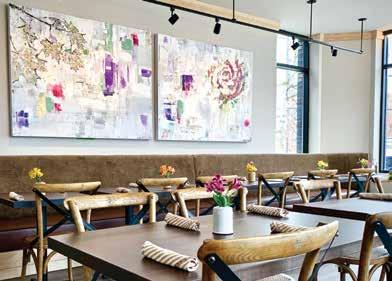

side order of prosciutto, to be stolen, magpie-style from another dish was brought without demur. To add to the fun, a selection of grocery items are for sale up front in the bar area, Katz’s vinegars, from California (naturally), or raw Sicilian olive oil, for example. The café also sells its own tote bag, along with linen tea towels and a selection of chunky tableware.
Not everything in the garden’s Rose-y. Sit too near the door and a wintry blast can assault you. And the acoustics can be a little unsympathetic if a large group is sitting anywhere near. Otherwise Maple & Rose is a boon, a great addition to the somewhat stultified Mamaroneck dining scene.
Situated next to the Dip-In car wash, plan it right and you can have your car washed while you enjoy breakfast or a lazy lunch. Then leave with a spring in your step, and head back to your vehicle.
“Let me tell you it’s always cool, And the boss don’t mind sometimes if you act the fool.” A great spot and a great lyric. Thank you, Rose Royce. And thank you Maple & Rose.
For reservations, visit maplerosecafe.com.
Top, The dining room seats about 40 and features custom artwork by local artist, Jenn Lewis, of Harrison; and, above, exterior of Maple & Rose at the Grand Street Lofts in Mamaroneck.
A NEW CHALLENGE FOR VINTNERS – GLOBAL WARMING
STORY AND PHOTOGRAPH BY DOUG PAULDING
For many generations, the world of wine was a relatively staid, sedentary and uncreative place with the noteworthy wine regions of Bordeaux, Burgundy, Rioja, Tuscany, Germany and the Douro River Valley producing the sought-after wines for the world. Most other regions produced wine for local consumption from grapes their grandparents planted and little of it moved far beyond their vines. Beginning around the discovery of the New World and the massive emigration that became the United States and Canada, winemakers travelled here with thoughts of plying their craft and dreams of partnering up or owning a winemaking operation. Croatianborn Mike Grgich (now of Grgich-Hills Winery) found a home in California and went to work. The Concannon and the Wente families both began operations in the late 1800s, along with a few others usually making sacramental or bulk wines for indiscriminate drinking and the kitchen.
And so it was for a few more generations until the 1976 “Judgment of Paris” (also the title of a great book by George M. Taber) when a British wine store owner, Steven Spurrier, proposed a blind wine challenge pitting some famous red and white wines of France against some relatively unknown California wines. The rules were established favoring French wines. The tasting was to be in Paris and the judges all were French. No one expected any judging surprises but the American wines took first place in both reds and whites as well as six of the top 10 spots in each category. And it changed the wine world. Fifteen years later, the collapse of the Soviet Union encouraged wine producers to switch from quantity to quality grapes and wine, and many former Soviet bloc and nearby countries began making interesting wines of substance and elegance. Think Turkey, Hungary, Croatia, Estonia, Georgia and many other “new FOOD & SPIRITS WINE & DINE
Spain’s Finca Villacreces winemaker Lluis Miquel Laso Roig is flanked by, from left, Mercedes Vazquez del Olmo, a Finca Villacreces wine tourism advocate, and Patricia Duran from the Ribera del Duero wine route office.

countries.” Many of these countries have an ancient wine history that was crushed by Soviet domination. They are now worthy and many are attractively priced. Grapes have become ubiquitous and now grow in all 50 U.S. states. There is so much information out there, from oenological schools, to libraries of wine books, to the internet, to professionals specializing in terroir who now know which specific geographical setting will support which specific grape for its most colorful expression. And from great grapes comes great wines. Often, remarkably enough, the wines of a region do have a symbiotic effect on the food culture, with the local wines and the regional cuisine complementing one another.
Today, we are witnessing another nascent revolution in the industry. Global warming is changing grape growing and winemaking. Many established wine producers are looking northward to continue with the grapes they have grown to love. The Pacific Northwest, including over the border into British Columbia, is being eyed as the new Napa and is producing many lovely wines. Germany, long known as a bastion of white wine production, is now experimenting with growing red grapes, which previously did not ripen up enough in that country’s colder climate. On a recent trip to the Ribera del Duero region in Spain, we visited one producer, Vinca Villacreces, immediately adjacent to Vega Sicilia, one of Spain’s best red wine producers. Vinca Villacreces makes great oak-aged red wines available at a fraction of the cost of Vega Sicilia and is looking ahead. It has planted an experiment station of many different grape types. The vines are now mature and producing, so Vega Sicilia is vinifying these grapes, oak aging and then bottling them unblended, to see which grapes are the best and most appropriate for the winery’s unique location when global warming inhibits growth of the its Tempranillo and Garnacha.
For most fruit growers, global warming just means the bud set time is earlier and the harvest time is sooner and the fruit grows quicker. No big deal. But grapes need hang time on the vine of around 100 days for the grapes to develop elegance and nuance. Fast ripening, valley floor grapes are usually destined for table grapes or uninteresting table wines. This puts grape growers on the leading edge of global warming effects. Worldwide, they are all harvesting earlier. Northern producers often exposed to early or late frosts or hailstorms, each of which can devastate or destroy a crop. Most southerly producers are liking it for now but are thinking ahead a decade or two, tryng to make adjustments for survival. Global warming, left uncorrected or unaddressed the next couple of decades, will be dramatic in the wine world. I have never found climate change deniers in the world of wine, because they are living it and are seeing it in their daily experiences in the vineyard. New and different vineyard pests need to be handled. And some previous pests are now capable of producing an additional generation per year for growers to address. Warm weather molds and mildews can have a profound affect on grape vines, inhibiting bud, leaf and fruit growth. The five years from 2014 to 2018 are the five warmest years ever recorded by the National Oceanic and Atmospheric Administration in the 139 years NOAA has been recording global temperatures. The year now is 2020. Twenty in French is “vingt,” pronounced very similar to the French word for wine, “vin.” So 2020 is pronounced “vin-vin,” for Wine-Wine. We are at a crossroads for addressing this warming phenom. It’s time to address what everyone knows. Vingt-vingt is the year. For the sake of the world, let us move forward. Write me at doug@dougpaulding.com.
Surf Club On The Sound
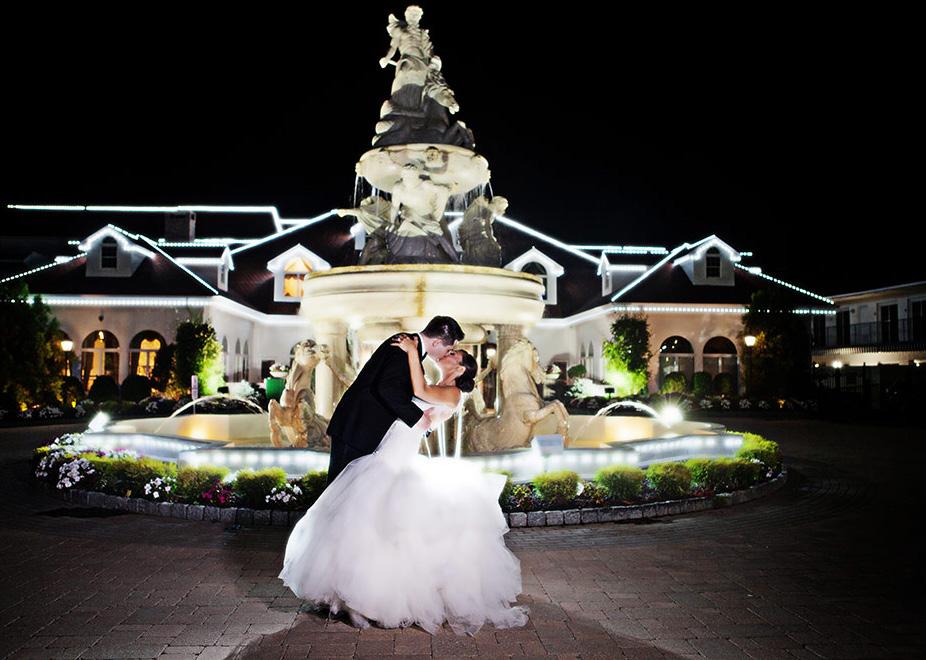
The Most Sought Out Wedding Venue in Westchester




The bridal experience at the award-winning Surf Club On The Sound is unlike any other venue. It starts from the moment you approach the fountain entrance and enter into the chandelier lit marble lobby with cascading staircase. Gorgeous architectural details and unbelievable waterfront grounds that transcend time, provide the perfect place for capturing those memorable wedding memories. Making brides dreams come true is our passion.










